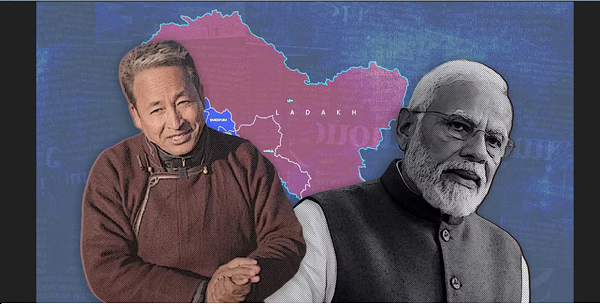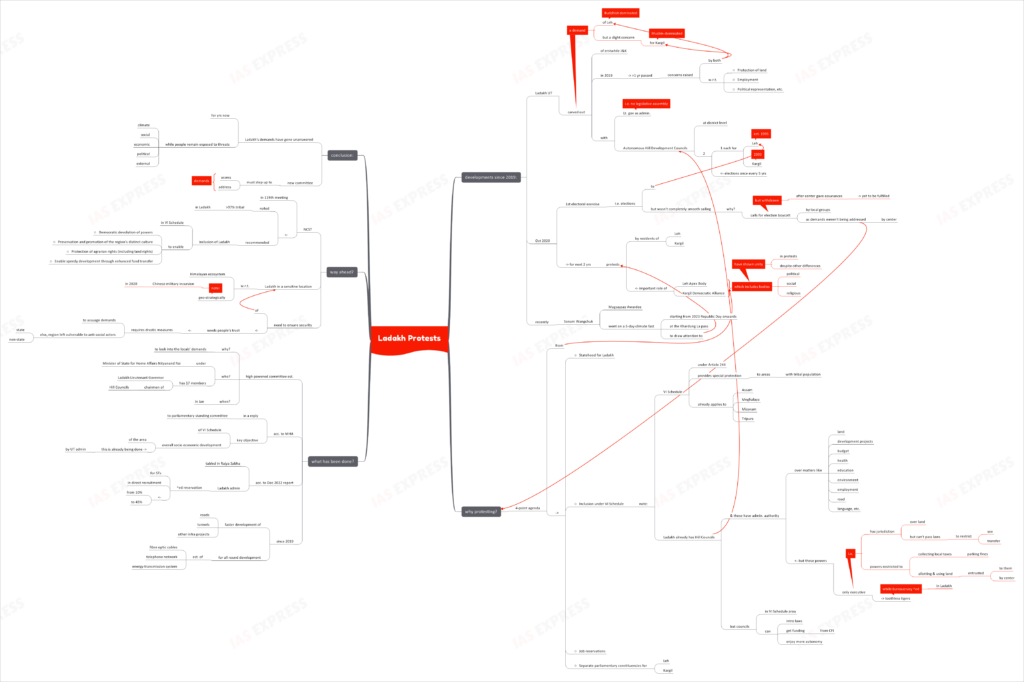Protests in Ladakh- Recent Developments, Reasons & Steps Taken

From Current Affairs Notes for UPSC » Editorials & In-depths » This topic
IAS EXPRESS Vs UPSC Prelims 2024: 85+ questions reflected
In January, Magsaysay Awardee Sonam Wangchuk undertook the 5-day climate fast, starting from the 2023 Republic Day onwards, at the Khardung La pass. This was an attempt to draw attention to the long-pending demands of the protestors in Ladakh.

How has Ladakh turned out since 2019?
- In 2019, the UT of Ladakh was carved out of the erstwhile Jammu & Kashmir. This status of separate UT was a long-pending demand of the Buddhist-dominated Leh region. However, the move triggered a degree of apprehension in Kargil, a Muslim-dominated region.
- After over a year passed, the two region raised concerns regarding a number of issues:
- Protection of land
- Employment
- Political representation, etc.
- The UT government is headed by a Lieutenant Governor and doesn’t have a Legislative Assembly.
- At the district level, administration is by the autonomous Hill Development Councils- one each for Kargil and Leh. The Hill Development Council of Leh was formed in 1995 whereas the one for Kargil was formed in 2003.
- Elections to these council are held once every 5 years.
- In October 2020, the new UT saw its first electoral exercise- elections to the 26-member Hill Council in Leh.
- Notably, this exercise wasn’t all smooth sailing as the local groups called for an election boycott. This boycott was withdrawn only after assurances from the central government with regards to the locals’ demands.
- The residents of Leh and Kargil have been protesting over 2 years seeking fulfilment of their demands.
- 2 notable entities in these long-growing protests are the Leh Apex Body and the Kargil Democratic Alliance- which includes political, social and religious bodies from the regions. In a show of unity, the two bodies have come together in these protests, despite their differences.
- Most recently, Magsaysay Awardee Sonam Wangchuk, went on a 5-day climate fast to urge the centre to take notice of the locals’ demands.
Why are there protests?
- A 4-point agenda was put forth by the 2 protesting bodies:
- Statehood for Ladakh
- Inclusion under VI Schedule
- Job reservations
- Separate parliamentary constituencies for Leh and Kargil
- Notably, while the recognition of Ladakh as a separate UT has been considered a win for the locals, it didn’t come with the expected inclusion under the VI Schedule of the Constitution.
- The VI Schedule, under Article 244 of the Constitution, provides special protection to areas with tribal population.
- The Schedule already applies to areas in Assam, Meghalaya, Mizoram and Tripura.
- While Ladakh already has Autonomous Hill Development Council with authority to take administrative calls on matters like land, development projects, budget, health, education, environment, employment, roads, language, etc., these are only executive powers.
- Meaning, the councils have jurisdiction over the land, but they can’t bring in laws to restrict the land’s use or transfer. Their powers are restricted to collecting local taxes (like parking fines) and allotting and using land entrusted to them by the central government.
- While the locals are concerned that the Hill Councils have been reduced to toothless tigers, the role of bureaucracy has increased in the region.
- On the other hand, the councils in the VI Schedule area can introduce laws, get funding from the Consolidated Fund of India and enjoy more autonomy.
What has been done?
- The centre constituted a 17-member high-powered committee, under Minister of State for Home Affairs Nityanand Rai, to look into the locals’ demands. Apart from the Ladakh Lieutenant Governor, it also includes the chairmen of the Leh and Kargil Autonomous Hill Councils.
- Earlier, in a reply to a parliamentary standing committee, the Home Affairs Ministry said that the key objective of including an area under the VI Schedule is to ensure the overall socio-economic development of the region. The Ministry held that this was already being done by the UT administration.
- According to the December 2022 report, tabled in the Rajya Sabha, the UT administration has increased the ST reservation in direct recruitment from 10% to 45%, to enable tribal development.
- Since 2019, the work on roads, tunnels and other infrastructure projects in the UT has picked up pace. Fibre optic cables, telephone network and energy transmission system are being developed to enable the region’s all-round development.
What is the way ahead?
- At its 119th meeting, the National Commission for Scheduled Tribes noted that more than 97% of Ladakh’s population is tribal. It recommended the UT’s inclusion in the VI Schedule to enable:
- Democratic devolution of powers
- Preservation and promotion of the region’s distinct culture
- Protection of agrarian rights (including land rights)
- Enable speedy development through enhanced fund transfer
- Ladakh has a sensitive location- with regards to the Himalayan ecosystem and also geo-strategically. The region suffered a major Chinese military incursion in 2020.
- It is vital for the central government to ensure the security of the region and the trust of locals is imperative. Without drastic measures to assuage the genuine demands of the locals, the region would be left vulnerable to anti-social actors- both state and non-state.
Conclusion:
It is unfortunate that Ladakh’s demands for inclusion under the VI Schedule has gone addressed for years, while the region’s people remain exposed to several threats- climate, social, economic, political and also external. It is imperative that the newly formed committee step up to assess and address the demands.
Practice Question for Mains:
Discuss the reasons behind the continued protests in Ladakh. What is the way ahead? (250 words)
If you like this post, please share your feedback in the comments section below so that we will upload more posts like this.

